| |
|
44.
 | In the absence of evidence to the contrary 02
| In the absence of evidence to the contrary 02 |
| |

'' We enter in the light, like a converted heart illuminated by divine revelation.
Unless this bright light ends up blinding us and turning us into fanatics. ''
François Salmeron, Paris-Art, 2014
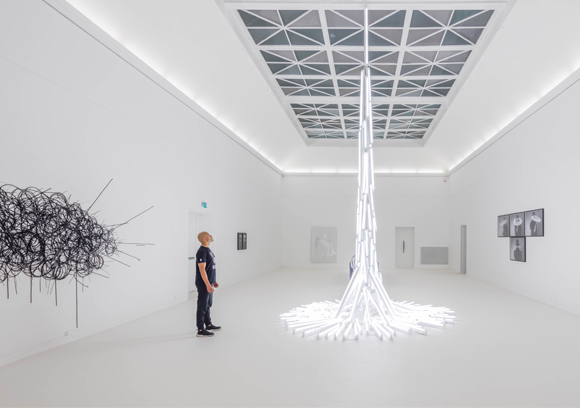
In the absence of evidence to the contrary 05
Exhibition View from 180° Behind me, Göteborg Konsthall, 2018, Göteborg.
Courtesy of the artist.
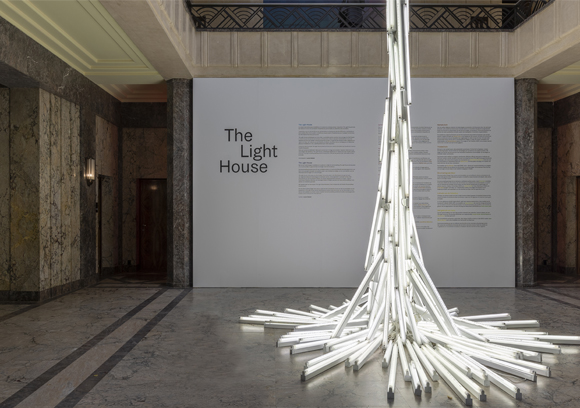
In the absence of evidence to the contrary 05
Exhibition View from The Light House, Boghossian Foundation, 2020, Brussels.
Courtesy of the artist.
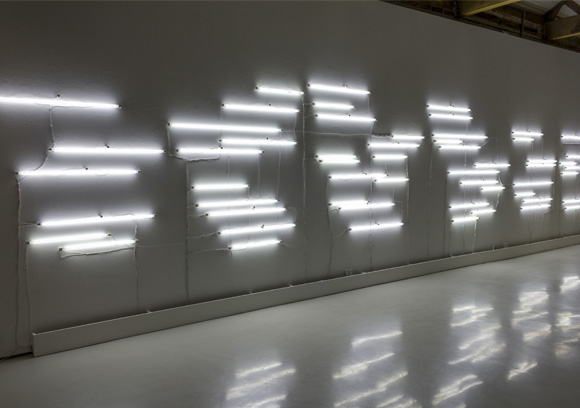
In the absence of evidence to the contrary 04
Exhibition view of Suspect Language, Goodman Gallery, 2012, Cape Town.
Courtesy of the artist.
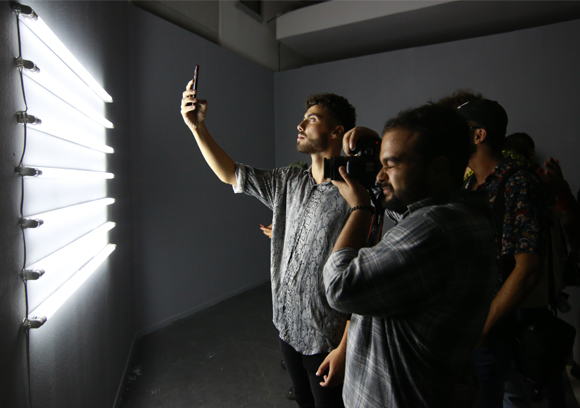
In the absence of evidence to the contrary 03
Exhibition view of Al-Tiba9 10th Anniversary, Al-Tiba9 Gallery, 2023, Barcelona.
Courtesy of the artist.
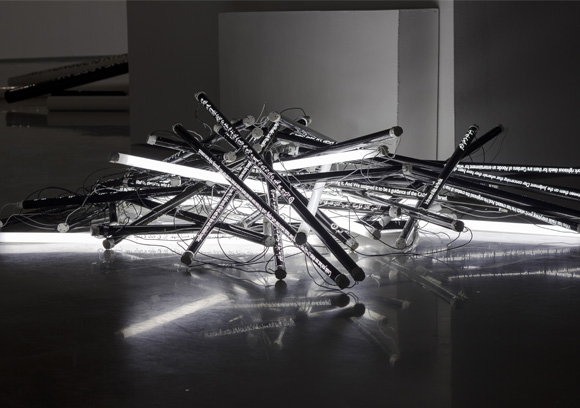
In the absence of evidence to the contrary 02
Exhibition view of Suspect Language, Goodman Gallery, 2012, Cape Town.
Courtesy of the artist.

In the absence of evidence to the contrary 01
Exhibition view from Horizons Croisés, 34e Moussem Culturel d'Assilah, 2012, Assilah.
Courtesy of the artist.
|
|
2012, fluorescent tubes, size may vary.
Exhibition view of Suspect Language, Goodman Gallery, 2012, Cape Town.
Courtesy of the artist and Ceysson & Bénétière, Paris.
Ed. of 1 + 1 A.P.
|
|
|
|
Jusqu’à preuve du contraire est une installation sculpturale composée de dizaines de néons se déployant du plafond vers le sol. Cette structure luminescente s’étend tel un arbre dans une dynamique ascendante. Les néons horizontaux, au sol, tiendraient place de racines tandis que les verticaux seraient un tronc puissant et massif s’élançant vers les cieux. Sur chacun des tubes est reproduit en anglais ou en arabe différents versets de la sourate 24 du Coran, intitulée « La lumière ». On peut donc apercevoir des maximes et impératifs moraux louant un dieu transcendant et omniscient et où la symbolique de la lumière lui est associée. Notamment dans le verset 36 où il est dit : « Dieu est la Lumière des cieux et de la terre. Sa lumière est semblable à une niche où se trouve une lampe. La lampe est dans un cristal, qui ressemble à un astre de grand éclat ; son combustible vient d’un arbre béni : un olivier ni oriental ni occidental dont l’huile semble éclairer sans même que le feu la touche. »
L’environnement direct de l’installation Jusqu’à preuve du contraire est inondé d’une lumière blanche intense et éblouissante. Cette lumière n’est pas sans rappeler celle de la divinité monothéiste. Se faisant lumière, Dieu ne s’incarne jamais véritablement et ne peut se représenter physiquement.
Cette symbolique de la présence divine par la lumière, aussi présente dans les œuvres de Dan Flavin, rappelle l’impact de la mouvance minimaliste dans l’œuvre de mounir fatmi. La proximité formelle est aussi visible que le principe d’organisation des matériaux avec Monument for V. Tatlin de Dan Flavin. Si l’artiste américain rend hommage au constructivisme russe et à ces principes architecturaux, mounir fatmi cultive avec Jusqu’à preuve du contraire une double référence. Cette installation qui, de prime abord, semble loin de la structure du monument pour la IIIe Internationale imaginé par Vladimir Tatlin en 1920, évoque le rapport à l’architecture dans l’appréhension de l’espace d’exposition chez mounir fatmi.
Ainsi, l’installation Jusqu’à preuve du contraire fonctionne comme un piège visuel. L’œil du spectateur se déplace d’une langue à l’autre, sans pouvoir fixer les écrits. Il est ainsi contraint à se rapprocher de la lumière pour pouvoir lire le texte sur les tubes luminescents. Dans cette épiphanie hypnotique, le texte visible teste notre persistance rétinienne. Provocant un chaos visuel, les tâches lumineuses restent imprimées, y compris paupières closent par un effet cinétique. Nos yeux gardent la mémoire du texte et nous projetons ce même texte sur tout ce que nous voyons. La lumière ne peut être qu’une expérience visuelle, ou plutôt une illusion visuelle. S’agit-il d’une révélation divine ? Cette lumière si vive, ne finit-elle pas par devenir aveuglante ? On peut se demander alors, si nous devons vraiment croire ce qu’on voit…jusqu’à preuve du contraire.
Studio Fatmi, Decembre 2016.
|
|
In the Absence of Evidence to the Contrary is a sculptural installation composed of dozens of fluorescent lights extending from the ceiling down to the floor. This luminescent structure stretches upwards like a tree. The horizontal neon lights spread across the floor, grounding the structure like roots, while the vertical lights evoke a powerful and colossal trunk reaching towards the sky. On each tube, different phrases are written in English or Arabic from sura 24 of the Quran, entitled, “The Light.” We can therefore discern adages or moral imperatives praising a transcendent and omniscient God, as well as the way in which he is associated with the symbolism of light. Notably in verse 36, it is written, “God is the light of the heavens and the earth. An image for his light is a niche in which there is a lamp placed in a glass. The glass is like a shining star which is lit from a blessed olive tree that is neither eastern nor western. Its oil seems to light up even though it has not been touched the fire.”
The environment of the In the Absence of Evidence to the Contrary installment is brimming with an intense, dazzling white light. This luster does not fail to bring to mind the light of monotheistic divinity. In becoming light, God is never truly incarnate and cannot be physically represented.
The symbolism of divine presence through light, also present in the work of Dan Flavin, recalls the impact of the minimalist movement in mounir fatmi’s piece. The proximity of shapes is as visible as the principal of organization of materials in Dan Flavin’s Monument for V. Tatlin. While the American artist pays tribute to Russian constructivism and these architectural principals, mounir fatmi cultivates a dual reference with In the Absence of Evidence to the Contrary. This installation, which at first seems very far removed from the structure of the Third International designed by Vladimir Tatlin in 1920, evokes the relationship to architecture in mounir fatmi’s apprehension of exhibition space.
In the Absence of Evidence to the Contrary therefore works as a visual trap. The eye of the spectator moves from one language to the other, without being able to define the words. He or she is thus required to approach the light in order to read the text on the luminescent tubes. In this hypnotic epiphany, the visible text tests our retinal tenacity. Visual chaos is provoked, luminous spots remain imprinted, and a kinetic effect closes the eyes. Our eyes retain the memory of the text and we project this text onto everything that we see. Light can only be a visual experience, or rather a visual illusion. Is it divine revelation? Does this bright light not become blinding? We may then wonder if we really must believe everything we see… until we have evidence to the contrary.
Studio Fatmi, December 2016.
Traduit du français par Christina Washington.
|
|
|
|